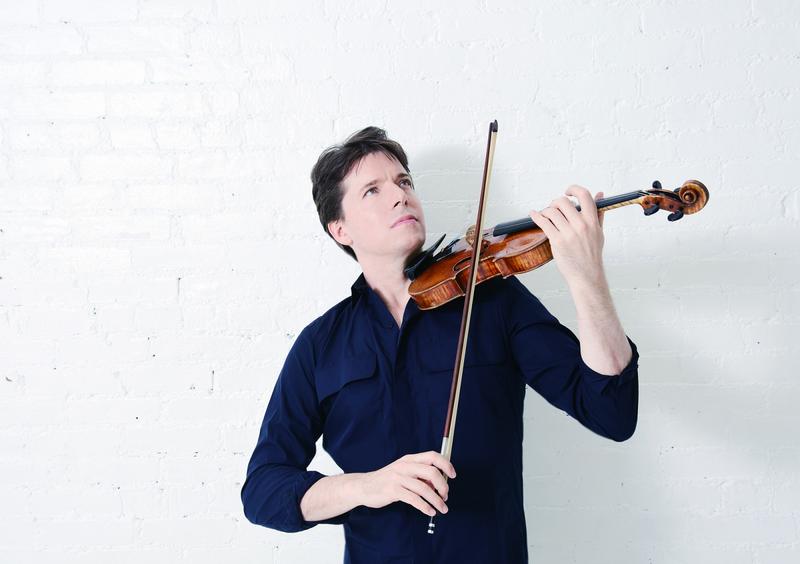Mixed results as Bell dons conductor hat with NSO

Joshua Bell performed as soloist and conductor with the National Symphony Orchestra Friday night.
In 2011, the Academy of St. Martin in the Fields appointed Joshua Bell to succeed its founding music director, Neville Marriner. The superstar American violinist has since led the celebrated chamber orchestra from the concertmaster’s chair and relished the role. He appeared as both soloist and conductor with the National Symphony Orchestra for the first time in 2017. Bell took center stage at the Kennedy Center Concert Hall for a belated return engagement Friday night.
Up to a certain critical mass, an orchestra can easily perform without a conductor. Bell, who is essentially self-taught from a decade of working with his British ensemble, mostly stayed out of the way of the NSO musicians in this crowd-pleasing program of music by Mendelssohn and Bruch. Much of the influence a conductor has over an orchestra comes down to charisma, and that is something Bell has in abundance—if not always a clear gesture and consistent beat.
Bell offered three approaches to a performer getting into the conducting game over the course of the evening. For the opener, Mendelssohn’s Overture to A Midsummer Night’s Dream, he sat in the concertmaster’s position, in the style of his ASMF work. Holding up his bow, he cued the mysterious wind chords that introduce the work, holding them long and taking extended breaks between them.
He then took up his violin with the rest of his section and launched into the running passages of the work’s main fairy-scherzo material. The NSO violins sounded a little out of synch at times, perhaps because they were watching both Bell and associate concertmaster, Ying Fu, who were stand partners. A missed woodwind entrance toward the middle of the work caused a brief moment of awkwardness, further suggesting perhaps that the work was under-rehearsed. The performance was otherwise adequate.
Under normal circumstances, Joshua Bell playing Bruch’s Violin Concerto No. 1 would be the highlight of the evening. The violinist now stood in the center of the orchestra, where the conductor’s podium would normally be, alternating between playing the demanding solo part and directing the explosive orchestra tuttis with his bow. Minor infelicities of intonation and accuracy crept into Bell’s technique, likely because serving in both roles gave him no chance to relax between the solo outings.
Although Bell must have worked on balances during rehearsals, it would have been helpful to have a conductor to assist with that and rhythmic coordination during the performance. Much of the first movement, a prologue to the slow movement at the concerto’s heart, is dominated by the soloist. At various points, both Fu and principal cellist David Hardy provided crucial assists in organizing the orchestra around Bell.
No question, however, that Bell, who knows this piece inside and out, delivered his trademark melting legato tone, especially in the first and second movements. The Finale was all about speed, and Bell took many risks with the pacing of the work. The NSO musicians mostly stayed with him, even though for much of this daunting third movement, Bell’s hands were mostly occupied with his violin.
On the second half was Mendelssohn’s Symphony No. 4, led by Bell who had neither violin nor baton in his hands, again in the space where the conductor’s podium would have been. This work takes its nickname, “Italian,” from the fact that the composer sketched most of it out during his stay in Italy in 1830, part of a grand tour of Europe that also yielded his Scotland-inspired pieces.
Bell zeroed in on the exuberance of the first movement with a daring, propulsive tempo, and the violin section coalesced brilliantly around Ying Fu, again seated in the concertmaster’s seat, on the movement’s familiar opening theme. Bell then doubled down on that bet, adding a rash accelerando at the coda, which drove apace to the movement’s end. Likewise, the second movement, inspired by a religious procession Mendelssohn experienced in Naples, could have been more solemn if Bell had held back the tempo a little more.
The third movement, a Minuet without a flashy tempo, felt drab and understated, albeit with nearly perfect horn playing in the Trio, as if sounding from a distance, and a perky flute solo. Not surprisingly, Bell maxed out on brashness in the Finale, pushing the edge of the Presto tempo marking to the breaking point. Combining elements of Roman and Neapolitan folk dances, the saltarello and tarantella, the music went beyond breathless into blurred, especially in the triplet patterns.
The program will be repeated 8 p.m. Saturday. kennedy-center.org
